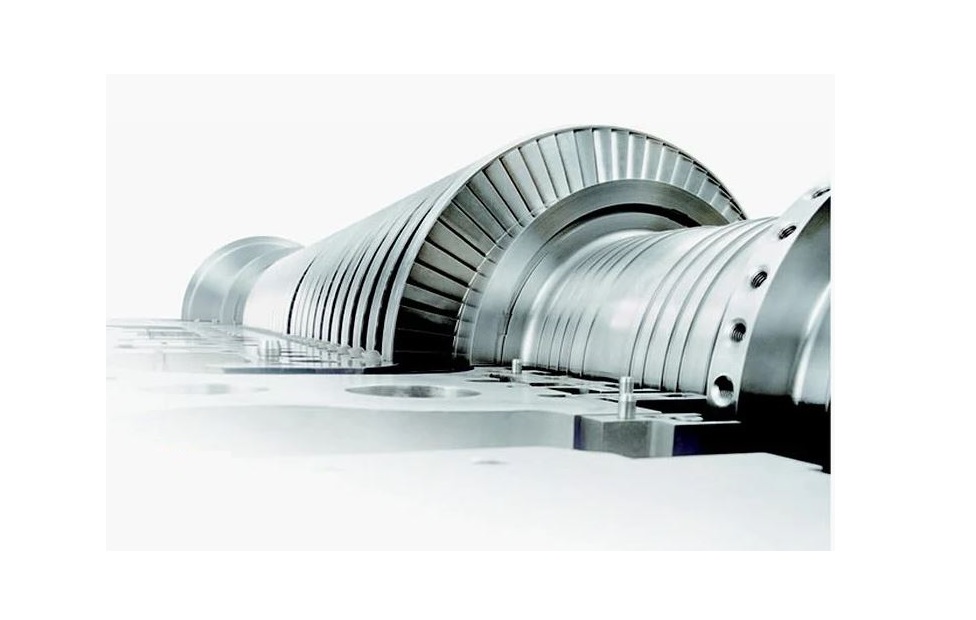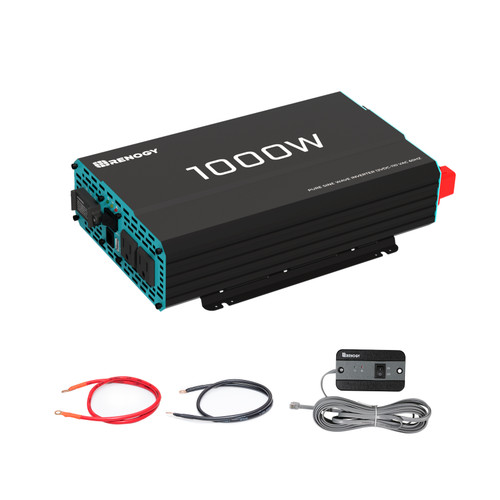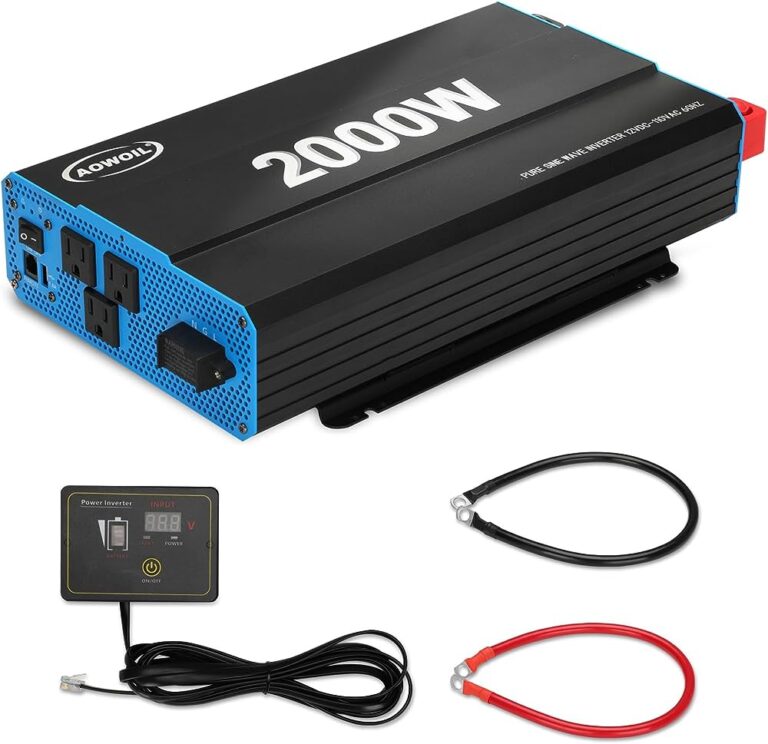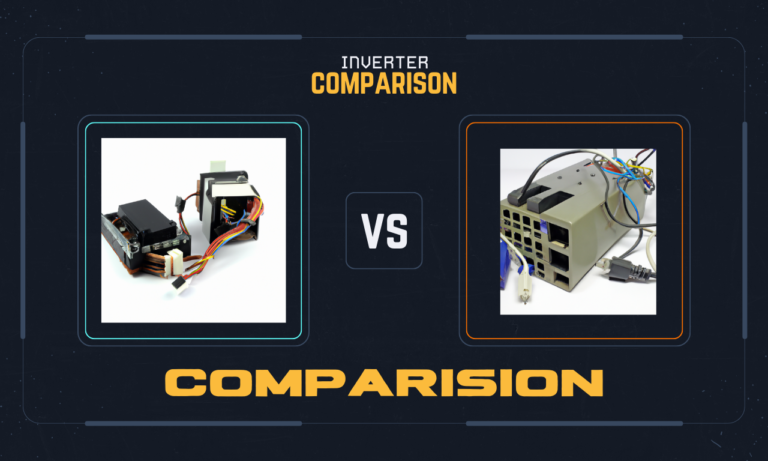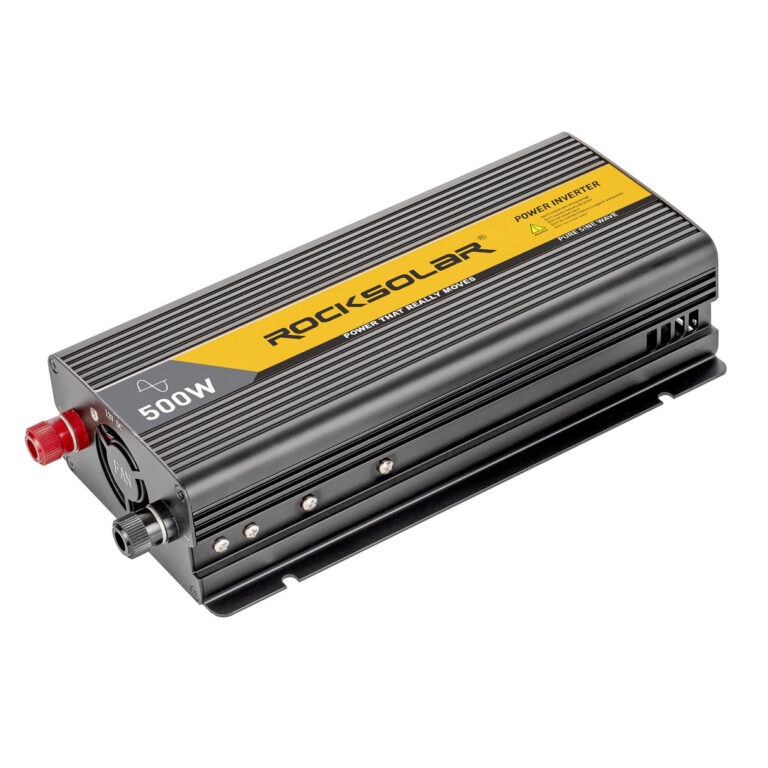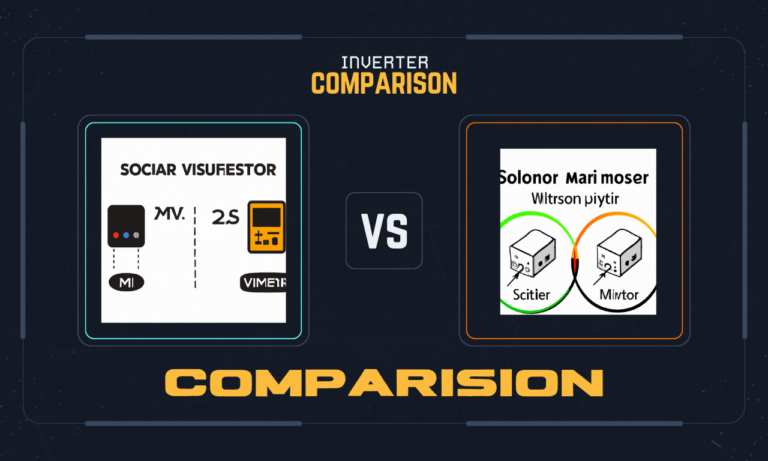How Does a Solar Inverter Synchronize With Grid: A Step-by-Step Guide
A solar inverter synchronizes with the grid by stepping down the inverter supply voltage to match the grid voltage and ensuring that the current and voltage are in phase with each other. The DC current generated by the solar panels is converted to the AC current needed to power appliances.
A grid-interactive inverter is commonly used in grid-connected solar electricity systems. With a grid-interactive solar inverter, the DC current generated by the solar panels is converted into AC current that matches the voltage and frequency of the grid. This allows the solar power to seamlessly integrate with the grid, ensuring that energy flows smoothly between the solar panels and the electrical grid.
The synchronization process involves adjusting the voltage and frequency output of the solar inverter to match the grid’s requirements, ensuring efficient and reliable power transfer. Overall, a solar inverter plays a crucial role in enabling the seamless integration of solar power into the grid.
Understanding Solar Power Components
The solar inverter plays a crucial role in synchronizing with the grid by converting the DC power from the solar panels into AC power that matches the grid’s voltage and frequency. This allows seamless integration of solar power into the existing grid infrastructure.
Solar Power Components Overview
Solar power systems consist of various components that work together to convert sunlight into usable electricity. Understanding these components is essential for comprehending how a solar inverter synchronizes with the grid. The main components of a solar power system include:
- Power Inverter: This device is responsible for converting the direct current (DC) electricity generated by solar panels into alternating current (AC) electricity that can be used to power household appliances and feed into the electrical grid.
- Solar Inverter: The solar inverter is specifically designed for solar power systems. It converts the DC electricity generated by solar panels into AC electricity that can be used locally or fed back into the grid.
- Charge Controller: The charge controller regulates the flow of electricity from the solar panels to the batteries. It prevents overcharging and extends the lifespan of the batteries.
- Photovoltaics: The photovoltaic (PV) panels, commonly known as solar panels, are responsible for absorbing sunlight and converting it into DC electricity. These panels are made up of multiple individual solar cells.
Power Inverter
A power inverter is a crucial component of a solar power system. Here are some important points to understand about power inverters:
- Power inverters convert DC electricity into AC electricity.
- They are responsible for supplying electricity to household appliances and feeding excess electricity into the grid.
- Inverters come in different sizes and capacities to meet various power requirements.
- Power inverters need to be synchronized with the grid to ensure efficient and safe operation.
Solar Inverter
A solar inverter is specifically designed for use in solar power systems. Here are some key points about solar inverters:
- Solar inverters convert DC electricity generated by solar panels into AC electricity suitable for use in homes and businesses.
- They have additional features and protections specifically designed for solar power systems.
- Solar inverters ensure that the power generated by solar panels is synchronized with the grid, allowing excess electricity to be fed back into the grid.
- Different types of solar inverters are available, including string inverters, microinverters, and power optimizers.
Charge Controller
The charge controller plays a vital role in managing the flow of electricity between the solar panels and batteries. Consider the following points about charge controllers:
- Charge controllers regulate the charging process to prevent overcharging and ensure optimal battery health.
- They help extend the lifespan of batteries by preventing deep discharging and overcharging, which can damage the batteries.
- Charge controllers also protect the entire solar power system by preventing voltage spikes and other electrical issues.
- Different types of charge controllers are available, including PWM (Pulse Width Modulation) and MPPT (Maximum Power Point Tracking) controllers.
Photovoltaics
Photovoltaic panels, commonly referred to as solar panels, are the primary component responsible for absorbing sunlight and converting it into usable electricity. Here are some important points about photovoltaics:
- Solar panels consist of multiple individual solar cells made of semiconductor materials.
- When sunlight hits the solar cells, it generates an electric current through the photovoltaic effect.
- The DC electricity generated by the solar cells is then converted to AC electricity by the solar inverter.
- The size and number of solar panels determine the overall power-generating capacity of the solar power system.
Understanding these solar power components provides a foundation for comprehending how a solar inverter synchronizes with the electrical grid. The interplay between these components ensures efficient energy conversion and utilization within a solar power system.
Exploring Types Of Solar Inverters
A solar inverter synchronizes with the grid by converting the DC electricity generated by solar panels into AC electricity that is compatible with the grid. This allows for seamless integration of solar power with the existing electrical grid system.
Solar energy is rapidly gaining popularity as a sustainable and cost-effective alternative to traditional energy sources. Solar panels, which convert sunlight into electricity, are a common sight on rooftops across the globe. But have you ever wondered how solar energy gets synchronized with the grid?
That’s where solar inverters come into play.
Solar inverters are essential components of solar energy systems as they convert the direct current (DC) produced by solar panels into alternating current (AC) that can be utilized by homes and businesses. In this section, we will explore different types of solar inverters and their unique features.
Let’s dive in:
Solaredge:
- SolarEdge is a leading manufacturer of solar inverters renowned for its innovative power optimization technology.
- This type of inverter allows for maximum power generation from each individual solar panel, enabling higher energy yields.
- SolarEdge inverters are known for their excellent performance in situations with shading or panel mismatch.
- They offer real-time monitoring capabilities, allowing users to track and optimize their solar energy production.
Enphase Energy:
- Enphase Energy is a prominent player in the solar inverter market, specializing in microinverters.
- Unlike traditional string inverters, microinverters are installed on each individual solar panel, providing better system performance and flexibility.
- Enphase microinverters offer advanced monitoring capabilities, allowing users to track the performance of each panel in real-time.
- This type of inverter also offers enhanced safety features, as it operates at the panel level rather than at the system level.
Grid-Tie Inverter:
- A grid-tie inverter, also known as a grid-interactive or grid-connected inverter, is designed to synchronize the solar energy system with the utility grid.
- This type of inverter allows surplus electricity produced by the solar panels to be fed back into the grid, reducing reliance on traditional energy sources.
- Grid-tie inverters offer the advantage of net metering, where excess energy production can be credited towards future electricity bills.
- They enable seamless integration of solar energy into the existing electrical grid infrastructure.
Sma Solar Technology:
- SMA Solar Technology is a leading global manufacturer of solar inverters, recognized for their industry expertise and reliability.
- Their inverters offer high efficiency, ensuring maximum power conversion from solar panels to the electrical grid.
- SMA inverters come with advanced grid management capabilities, ensuring stable grid synchronization and reliable operation.
- They also offer comprehensive monitoring solutions, allowing users to remotely monitor their solar energy production and performance.
Power Optimizer:
- Power optimizers are an innovative addition to the solar inverter market, designed to increase the performance of solar panels.
- They optimize the power output of each individual solar panel, reducing the effects of shading, soiling, and panel mismatch.
- Power optimizers work in conjunction with a central inverter or microinverters, enhancing overall system efficiency and output.
- They enable panel-level monitoring, providing insights into the performance of each solar panel and facilitating proactive maintenance.
Solar inverters play a crucial role in synchronizing solar energy with the grid. Different types of solar inverters offer unique advantages and features. Whether it’s SolarEdge’s power optimization technology, Enphase Energy’s microinverters, or SMA Solar Technology’s reliability, there is a solar inverter solution to suit every solar energy system.
Best Solar Inverters On The Market
Solar inverters synchronize with the grid by converting the direct current (DC) generated by the solar panels into alternating current (AC) that is compatible with the grid. This allows solar energy to be seamlessly fed into the electrical grid, providing power to homes and businesses.
Best Solar Inverters Overview:
When it comes to choosing the best solar inverter for your solar power system, there are several top-notch options available in the market. These inverters are designed to efficiently synchronize your solar power with the grid, maximizing the utilization of renewable energy.
Let’s take a closer look at some of the best solar inverters on the market that can help you achieve seamless synchronization with the grid.
Victron Multiplus Inverter/Charger:
- Provides a reliable and seamless transition between solar power and grid power.
- Offers multi-functional capabilities, serving as an inverter, charger, and transfer switch.
- Features advanced technology for superior performance and efficiency.
- Comes with built-in protection mechanisms to safeguard your solar power system.
Sungoldpower 6500W 48V Solar Charger Inverter:
- Offers high power output and efficiency for effective synchronization.
- Equipped with multiple safety features for reliable operation.
- Provides multiple charging options and can be used for hybrid systems.
- Suitable for both residential and commercial applications.
Growatt 12Kw Split Phase Off-Grid Inverter:
- Ideal for off-grid solar power systems.
- Provides stable and reliable synchronization with the grid.
- Supports split-phase output for better flexibility.
- Comes with advanced monitoring and control functions for easy management.
Renogy Rng-Invt-3000W 12V Pure Sine Wave Inverter:
- Delivers clean and stable power for efficient grid synchronization.
- Offers multiple safety features for reliable and safe operation.
- Suitable for a wide range of applications, from RVs to off-grid homes.
- Compact and lightweight design for easy installation.
Dewalt Dxaepi1000 Power Inverter:
- Designed for portable solar power systems.
- Provides reliable synchronization between solar power and the grid.
- Features rugged construction for durability in various environments.
- Equipped with advanced safety features for worry-free usage.
With these top-quality solar inverters, you can ensure that your solar power system synchronizes seamlessly with the grid, maximizing energy efficiency and contributing to a greener future. Select the one that best suits your needs and start enjoying the benefits of solar power today.

Credit: issuu.com
How Solar Inverters Sync With The Power Grid
Converts the DC power generated by the solar panels into AC power that can be synchronized with the power grid. This synchronization ensures that the solar energy is seamlessly integrated into the grid, allowing for efficient and reliable power distribution.
Understanding The Sync Process:
When it comes to synchronizing a solar inverter with the power grid, there are several important steps involved. Let’s take a closer look at each step to understand how solar inverters sync with the power grid:
Step 1: Dc To Dc Converter:
- The DC to DC converter in a solar inverter converts the direct current (DC) generated by the solar panels into a form that can be used by the inverter.
- This converter ensures that the solar panels are providing the optimal DC voltage to the inverter for further processing.
Step 2: Voltage And Current Adjustment:
- After the DC to DC conversion, the inverter adjusts the voltage and current levels of the DC electricity to match the standards of the power grid.
- This adjustment ensures that the electricity generated by the solar panels aligns with the grid’s requirements, enabling seamless integration.
Step 3: Phase Synchronization:
- Phase synchronization is crucial for the solar inverter to sync with the power grid.
- The inverter analyzes the phase of the grid’s electricity and adjusts its own phase accordingly.
- This synchronization ensures that the solar inverter and the power grid are in harmony, preventing any potential disruptions or power imbalances.
Step 4: Grid Connection:
- Once the solar inverter is synchronized with the power grid, it establishes a connection to feed the generated electricity into the grid.
- This connection allows the excess solar energy to be shared with other users on the grid, maximizing the utilization of renewable energy.
Step 5: Monitoring And Control:
- To ensure the efficient operation of the solar inverter and the grid synchronization, monitoring and control systems are in place.
- These systems continuously monitor the performance of the inverter, detect any abnormalities, and enable effective control mechanisms if needed.
- Monitoring and control play a vital role in maintaining stability and reliability in the grid synchronization process.
The synchronization of solar inverters with the power grid involves multiple steps, including DC to DC conversion, voltage and current adjustment, phase synchronization, grid connection, and monitoring and control. These steps work together to ensure a seamless and efficient integration of solar energy into the existing power grid, contributing to a greener and more sustainable future.
How Does an Inverter on a Generator Synchronize With Grid?
Inverter on a generator synchronizes with the grid by intelligently converting the generated AC power into DC and then back to AC, ensuring compatibility with the grid’s frequency. This allows for seamless power transfer between the generator and the utility grid, facilitating a smooth integration of renewable energy sources. How does an inverter on a generator work? It converts electricity efficiently, maintaining a harmonious connection with the grid power supply.
Frequently Asked Questions Of How Does A Solar Inverter Synchronize With Grid
How Do You Sync Solar Power With A Grid?
To sync solar power with a grid, the solar inverter plays a crucial role. It converts the direct current (DC) generated by solar panels into alternating current (AC) at 230 volts, which is the standard voltage for running appliances. The inverter ensures that the current and voltage are in phase with each other.
The solar panel’s supply voltage is directed to a DC to DC converter for synchronization. This synchronization process allows the solar power system to integrate seamlessly with the power grid. A grid-interactive inverter is the most commonly used type of inverter for grid-connected solar systems.
How Does A Solar Inverter Work With Grid?
A solar inverter is an essential component of a grid-connected solar system. It converts the direct current (DC) produced by solar panels into alternating current (AC), which is the type of electricity used by standard household appliances. This allows the solar electricity generated by the panels to be used directly in your home or business, or even fed back into the electrical grid.
The most common type of solar inverter used in grid-connected systems is a grid-interactive inverter. This inverter is designed to synchronize with the electrical grid and match the grid’s voltage and frequency. It ensures that the solar electricity flows in sync with the grid, allowing for seamless integration and efficient use of the solar power.
Overall, a solar inverter plays a crucial role in converting the DC electricity produced by solar panels into usable AC electricity that can power your home or business, while also enabling the connection to the electrical grid.
How Does An Inverter Feed Power Back To The Grid?
A solar inverter feeds power back to the grid by converting the DC current generated by the solar panels into AC current that is synchronized with the grid’s voltage and frequency. This allows the electricity produced by the solar panels to be directly used by electrical appliances in the building and any excess power is sent back to the grid.
The inverter is responsible for ensuring that the AC current produced is of the same quality as the grid’s electricity, maintaining the voltage and frequency within the required limits. This synchronization process ensures that the solar energy integrates seamlessly with the existing grid infrastructure, allowing for efficient utilization and distribution of renewable energy.
Grid-interactive inverters, which are commonly used in grid-connected solar systems, enable this two-way flow of electricity between the solar panels and the grid.
What Is Synchronization In Inverter?
Synchronization in an inverter refers to the process of aligning the output of the inverter with the electrical grid. It ensures that the voltage and frequency of the inverter’s output match the grid’s voltage and frequency, allowing seamless integration and efficient power transfer.
The inverter converts the DC current generated by solar panels into AC current, which is compatible with the grid. By synchronizing with the grid, the inverter can supply excess electricity back to the grid or draw power from the grid when needed.
This synchronization is crucial for grid-tied solar systems to ensure optimal performance and safety.
Conclusion
To summarize, the synchronization of a solar inverter with the grid is a crucial process in a grid-connected solar electricity system. The solar inverter plays a vital role in converting the DC current generated by solar panels into the required 230 volt AC current for operating appliances.
This synchronization ensures that the inverter’s supply voltage matches the grid voltage, allowing for a smooth transfer of power. By utilizing a DC to DC converter, the supply voltage from the solar panels is stepped down to match the grid voltage, ensuring that the current and voltage remain in phase with each other.
This synchronization process enables efficient power transfer and ensures that the solar system is seamlessly integrated into the grid. Understanding how a solar inverter synchronizes with the grid is essential for optimizing the performance and reliability of a grid-connected solar system.
By adhering to proper synchronization protocols, solar system owners can maximize energy production and contribute to a more sustainable and environmentally friendly future.

